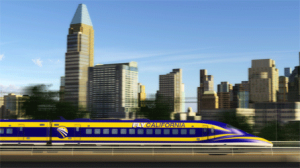Cap-and-trade funds targeted for high-speed rail project
by Kathy Hamilton | July 18, 2015 6:00 am
 [1]Bills being introduced that monitor or change terms for the state’s high-speed rail project are a rarity. However, there are two bills brewing in the Legislature.
[1]Bills being introduced that monitor or change terms for the state’s high-speed rail project are a rarity. However, there are two bills brewing in the Legislature.
One has a shot at passing. The other doesn’t.
Senate Bill 400 would require the California High-Speed Rail Authority to use at least 25 percent of its cap-and-trade funds for projects to reduce or offset construction emissions. The bill comes as two groups have brought legal challenges to the state’s cap-and-trade program and the state’s plan for measuring emissions from the high-speed rail project. The bill traces its origins to the powerful Hispanic caucus and is expected to pass in the largely pro-rail legislature.
SB400, introduced by Sen. Ricardo Lara, D-Bell Gardens, has been approved in the Senate and is moving through committees in the Assembly.
Last year the Legislature appropriated 25 percent of the state’s revenues from cap-and-trade auctions to the high-speed rail project. SB400 would reduce construction funds to 18.75 percent of the revenues, with the remainder going to “reduce or offset greenhouse gas (GHG) emissions directly associated with the construction of the high-speed rail project and provide a co-benefit of improving air quality,” according to a Senate analysis of the bill.
The analysis suggests that this bill might save the cap-and-trade program, which is being challenged by two lawsuits.
Lawsuits against AB32 and HSR
A suit brought by the Pacific Legal Foundation[2], which favors[3] limited government and “sensible environmental policies,” claims that the very existence of the cap-and-trade program is an illegal tax. The case is on appeal and expected to be heard in the fall.
A second suit[4] asserts that a state plan to reduce emissions improperly calculated the impact of the high-speed rail project — which the plaintiffs allege will actually contribute to greenhouse gases instead of reduce them.
The plaintiffs in their complaint say that the state’s estimates “were neither real, permanent, quantifiable or verifiable but were instead illusory because in reality the construction of the (rail) project would result in a significant increase in (greenhouse gas) emissions prior to 2030 or beyond.”
The suit is being brought by the Transportation Solutions Defense and Education Fund, a nonprofit environmental group.
Cap and trade bailing out high-speed rail project
The rail project is not slated to be operational by 2020, which is the deadline in state law to reduce the state’s greenhouse gas emissions to 1990 levels.
The Senate analysis[5] points out that state law restricts the use of cap-and-trade funds.
“The Constitution requires that a clear nexus exist between an activity for which a mitigation fee is used and the adverse effects related to the activity on which that fee is levied. …
“It is important that legislation allocating cap-and-trade revenues ensure that the funds are being used to reduce (greenhouse gas) emissions. If opponents of the program can convince the courts that the revenues are not being used appropriately, the entire cap-and-trade program could be jeopardized.”
The analysis hints that the rail program’s use of cap-and-trade funds, as currently outlined, doesn’t meet legal standards, and that passage of the bill would shore up the legal standing of the program and help the state win the pending court cases.
“If opponents of the program can convince the courts that the revenues are not being used appropriately, the entire cap-and-trade program could be jeopardized,” the analysis reads.
The cap-and-trade program is estimated[6] to bring in as much as $2 billion a year in fees.
Further analysis on SB400
An analysis in the Assembly[7] shows that some lawmakers remain sympathetic to the aims of the bill but not as positive on its potential effects.
The bill would significantly drive up the cost of the rail project by reducing its only stable revenue stream, according to a summary of transportation committee members’ concerns. This could threaten completion and jeopardize any future environmental benefits.
“The project is already sorely underfunded,” the analysis states.
The analysis also points out that SB400 is intended to offset environmental impacts from construction but does not impose any requirement that the redirected money, approximately $125 million, be spent in communities near the construction zones. The bill could result in “millions of dollars being spent in Southern California, hundreds of miles from the high-speed rail construction sites.”
In other words, it could result in a money grab for other transit projects in Southern California, not the “disadvantaged communities” proposed in the bill.
Republicans in the Legislature have been unsuccessful for the past three years with more than a dozen bills that attempted to manage, change or end the high-speed rail program. All failed on party-line votes to get out of committee. In fact, Rep. Jim Patterson, R-Fresno, has a graveyard with little tomb stone markers set up in his backyard for failed bills he’s introduced on various subjects including high-speed rail.
Despite the fact that Senate Bill 3 has bipartisan sponsorship, from Sens. Andy Vidak, R-Hanford, and Rudy Salas, D-Bakersfield, it’s expected to suffer a similar fate.
The bill would direct the Legislature to approve putting high-speed rail back on the ballot. It would redirect high-speed rail funds to retiring the debt incurred from the issuance and sale of bonds. It would also require that unsold bonds use half the net proceeds for funding repair and new construction projects on state highways and freeways. The other half would be used to fund projects on local streets and roads.
- [Image]: http://calwatchdog.com/wp-content/uploads/2015/03/high-speed-rail-in-city.png
- Pacific Legal Foundation: http://blog.pacificlegal.org/its-cap-and-trade-time-again/
- favors: http://www.pacificlegal.org/about1
- A second suit: http://transdef.org/HSR/ARB.html
- The Senate analysis: http://leginfo.legislature.ca.gov/faces/billAnalysisClient.xhtml?bill_id=201520160SB400
- estimated: http://leginfo.legislature.ca.gov/faces/billAnalysisClient.xhtml?bill_id=201520160SB400#
- analysis in the Assembly: http://leginfo.legislature.ca.gov/faces/billAnalysisClient.xhtml?bill_id=201520160SB400
Source URL: https://calwatchdog.com/2015/07/18/high-speed-rail-dollars-cap-trade-targeted/